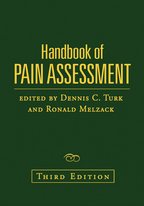Handbook of Pain Assessment
Third Edition
Edited by Dennis C. Turk and Ronald Melzack
Hardcovere-bookprint + e-book
Hardcover
orderNovember 22, 2010
ISBN 9781606239766
Price: $104.00542 Pages
Size: 7" x 10"
“The individual chapters are well written, thorough, and an excellent source of information. This volume will undoubtedly prove extremely useful to researchers in decision making concerning instruments to use for the assessment of pain and related variables (e.g., physical and psychological functioning, pain beliefs, and coping strategies) for particular purposes or with specific populations....[It] also will be useful for clinicians of different specialties that wish to learn more about the assessment of patients with pain.”

—APS (American Pain Society) Bulletin (on previous edition)
“This book should be on the bookshelf of anyone who treats patients with chronic pain, anyone who is called upon to assess patients for pain, and anyone who has to teach others how to properly monitor pain states. I would recommend that this book be available to all students, interns, and residents in training programs as a reference when they have patients with pain.”

—Psychosomatics (on previous edition)
“Extremely useful both for researchers and clinicians….Researchers might use it to find new useful measurement instruments or review the latest research on these means of assessment. Clinicians from many specialties may find the book useful for learning more about assessing and understanding the pain their patients may be experiencing. This book is recommended for all kinds of medical libraries, from clinical and hospital libraries to academic research libraries.”

—E-Streams
“This is the authoritative reference on pain assessment, and has been since the first edition. The Handbook integrates the rapidly growing body of assessment research into a single manageable volume. It reminds us that identifying and measuring meaningful behavioral outcomes—assessing the patient and not just the pain—is the key to the process. The third edition covers new instruments, methods, and procedures, as well as the latest refinements of older instruments. Importantly, it also cautions us not to blindly accept any measure, even the most technical and face-valid. A 'must have' for health care professionals and students.”

—Beverly E. Thorn, PhD, ABPP, Department of Psychology, University of Alabama
“There is simply no other text or resource that so thoroughly defines the current status of pain assessment. This book is critical to understanding that we do have tools that can help us to objectify the pain experience, even though we are still without a pain ‘meter’ to measure the subjective level of a person’s suffering. With careful assessment, a more effective pain therapy regimen can be created. The importance of assessing the biopsychosocial factors that contribute to the pain experience is still undervalued and underutilized. This well-written, easy-to-read volume from some of the most eminent specialists in the field should be required reading for all health professionals who come into contact with people in pain.”

—Margaret Caudill-Slosberg, MD, PhD, MPH, Departments of Anesthesiology and Community and Family Medicine, Dartmouth Medical School
—APS (American Pain Society) Bulletin (on previous edition)
“This book should be on the bookshelf of anyone who treats patients with chronic pain, anyone who is called upon to assess patients for pain, and anyone who has to teach others how to properly monitor pain states. I would recommend that this book be available to all students, interns, and residents in training programs as a reference when they have patients with pain.”
—Psychosomatics (on previous edition)
“Extremely useful both for researchers and clinicians….Researchers might use it to find new useful measurement instruments or review the latest research on these means of assessment. Clinicians from many specialties may find the book useful for learning more about assessing and understanding the pain their patients may be experiencing. This book is recommended for all kinds of medical libraries, from clinical and hospital libraries to academic research libraries.”
—E-Streams
“This is the authoritative reference on pain assessment, and has been since the first edition. The Handbook integrates the rapidly growing body of assessment research into a single manageable volume. It reminds us that identifying and measuring meaningful behavioral outcomes—assessing the patient and not just the pain—is the key to the process. The third edition covers new instruments, methods, and procedures, as well as the latest refinements of older instruments. Importantly, it also cautions us not to blindly accept any measure, even the most technical and face-valid. A 'must have' for health care professionals and students.”
—Beverly E. Thorn, PhD, ABPP, Department of Psychology, University of Alabama
“There is simply no other text or resource that so thoroughly defines the current status of pain assessment. This book is critical to understanding that we do have tools that can help us to objectify the pain experience, even though we are still without a pain ‘meter’ to measure the subjective level of a person’s suffering. With careful assessment, a more effective pain therapy regimen can be created. The importance of assessing the biopsychosocial factors that contribute to the pain experience is still undervalued and underutilized. This well-written, easy-to-read volume from some of the most eminent specialists in the field should be required reading for all health professionals who come into contact with people in pain.”
—Margaret Caudill-Slosberg, MD, PhD, MPH, Departments of Anesthesiology and Community and Family Medicine, Dartmouth Medical School



